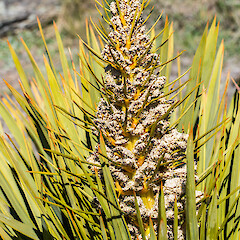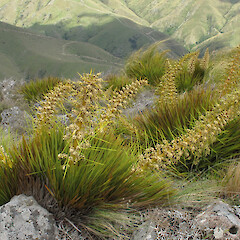Aciphylla aurea
Common name
golden spaniard, golden speargrass
Family
Apiaceae
Flora category
Vascular – Native
Endemic taxon
Yes
Endemic genus
No
Endemic family
No
Structural class
Herbs - Dicotyledons other than Composites
NVS code
The National Vegetation Survey (NVS) Databank is a physical archive and electronic databank containing records of over 94,000 vegetation survey plots - including data from over 19,000 permanent plots. NVS maintains a standard set of species code abbreviations that correspond to standard scientific plant names from the Ngä Tipu o Aotearoa - New Zealand Plants database.
ACIAUR
Chromosome number
2n = 22
Current conservation status
The conservation status of all known New Zealand vascular plant taxa at the rank of species and below were reassessed in 2017 using the New Zealand Threat Classification System (NZTCS) – more information about this can be found on the NZTCS website. This report includes a statistical summary and brief notes on changes since 2012 and replaces all previous NZTCS lists for vascular plants.
Please note, threat classifications are often suggested by authors when publications fall between NZTCS assessment periods – an interim threat classification status has not been assessed by the NZTCS panel.
- Conservation status of New Zealand indigenous vascular plants, 2017 . 2018. Peter J. de Lange, Jeremy R. Rolfe, John W. Barkla, Shannel P. Courtney, Paul D. Champion, Leon R. Perrie, Sarah M. Beadel, Kerry A. Ford, Ilse Breitwieser, Ines Schönberger, Rowan Hindmarsh-Walls, Peter B. Heenan and Kate Ladley. Department of Conservation. Source: NZTCS and licensed by DOC for reuse under the Creative Commons Attribution 4.0 International licence.
2017 | Not Threatened
Previous conservation statuses
2012 | Not Threatened
2009 | Not Threatened
2004 | Not Threatened
Brief description
Robust yellowish-green golden large spikey clumps to 1 m with a tall robust very spikey flower head
Habitat
Montane to low alpine well-drained or arid sites including rocky areas, dry grassland and tussock grassland. 300-1500 m.
Wetland plant indicator status rating
Information derived from the revised national wetland plant list prepared to assist councils in delineating and monitoring wetlands (Clarkson et al., 2021 Manaaki Whenua – Landcare Research Contract Report LC3975 for Hawke’s Bay Regional Council). The national plant list categorises plants by the extent to which they are found in wetlands and not ‘drylands’. The indicator status ratings are OBL (obligate wetland), FACW (facultative wetland), FAC (facultative), FACU (facultative upland), and UPL (obligate upland). If you have suggestions for the Wetland Indicator Status Rating, please contact: [Enable JavaScript to view protected content]
UPL: Obligate Upland
Rarely is a hydrophyte, almost always in uplands (non-wetlands).
Detailed description
Very robust tufted yellowish-green herb to 1.5 m tall when in flower. Rosettes single or multiple, to 1 m diameter. Leaves many, stout, 1-pinnate to irregularly 2-pinnate (sometimes only 1 secondary pinna developed), to 70 cm long; sheath thick with thin margins, yellow or yellowish-green, 25 mm wide at apex; stipules stout, to 27 cm long x 5-8 mm wide, tapering, pungent; petioles c. 10-20 cm long x 10-16 mm wide; margins finely serrulate on cartilaginous margin; internodes (inter-pinna spacing) 5-6 cm long; primary pinnae 2-4 pairs, spaced, flat, striate, midrib obscure, c. 20 cm long x 7 mm wide, abrubtly narrowing to pungent point; secondary pinnae little shorter, pungent. Flowering stem of male and female similar (female narrower and darker), stout, ribbed, 80 cm or more long, bracted along most of length; bracts +/- erect in male, spreading in female; lower bracts without flowers, yellow; lower bract sheaths to 8 x 1.5 cm tapering to c. 9 mm wide, thin, smooth; lower bract stipules to 8 cm long x 2-3 mm wide, acicular; lower bract lamina usually simple, sometimes bifid, to 22 cm long x 4 mm wide, acicular. Umbels of male plants distributed along peduncle; involucral bracts linear, longer than rays. Umbels of female plants on peduncles up to 15 cm long; umbellules crowded on short rays; involucral bracts linear. Fruit of two mericarps; mericarps oblong-elliptic to elliptic, (3.5-)4.0-6.0(-6.5) mm, with 3-4 narrowly winged ribs and 1-2 reduced to low ridges, vittae obscured
Similar taxa
Similar to Aciphylla colensoi which has much shorter stipules and crowded pinnae on leaves and also A. horrida which has usually 1-pinnate leaves and inflorescences very broad at the base
Flowering
November-December
Flower colours
Cream, Yellow
Fruiting
January-February
Etymology
aciphylla: From the Latin acicula ‘needle’ and the Greek phyllum ‘leaf’, meaning needle-leaf.
aurea: Golden yellow
Attribution
Description adapted by Mike Thorsen from Allan (1961), Mark and Adams (1995), Webb and Simpson (2001) and Wilson (1996).
References and further reading
Allan, H.H. 1961. Flora of New Zealand. Government Printer, Wellington;
Mark, A.F; Adams, N.M. 1995. New Zealand alpine plants, 2nd Edition. Godwit Publishing, Auckland;
Thorsen, M. J.; Dickinson, K. J. M.; Seddon, P. J. 2009. Seed dispersal systems in the New Zealand flora. Perspectives in Plant Ecology, Evolution and Systematics 2009 Vol. 11 No. 4 pp. 285-309
Webb, C.J. & Simpson, M.J.A. 2001. Seeds of NZ gymnosperms and dicotyledons. Manuka Press, Christchurch;
Wilson, H.D. 1996. Wild plants of Mount Cook National Park. Manuka Press, Christchurch

















